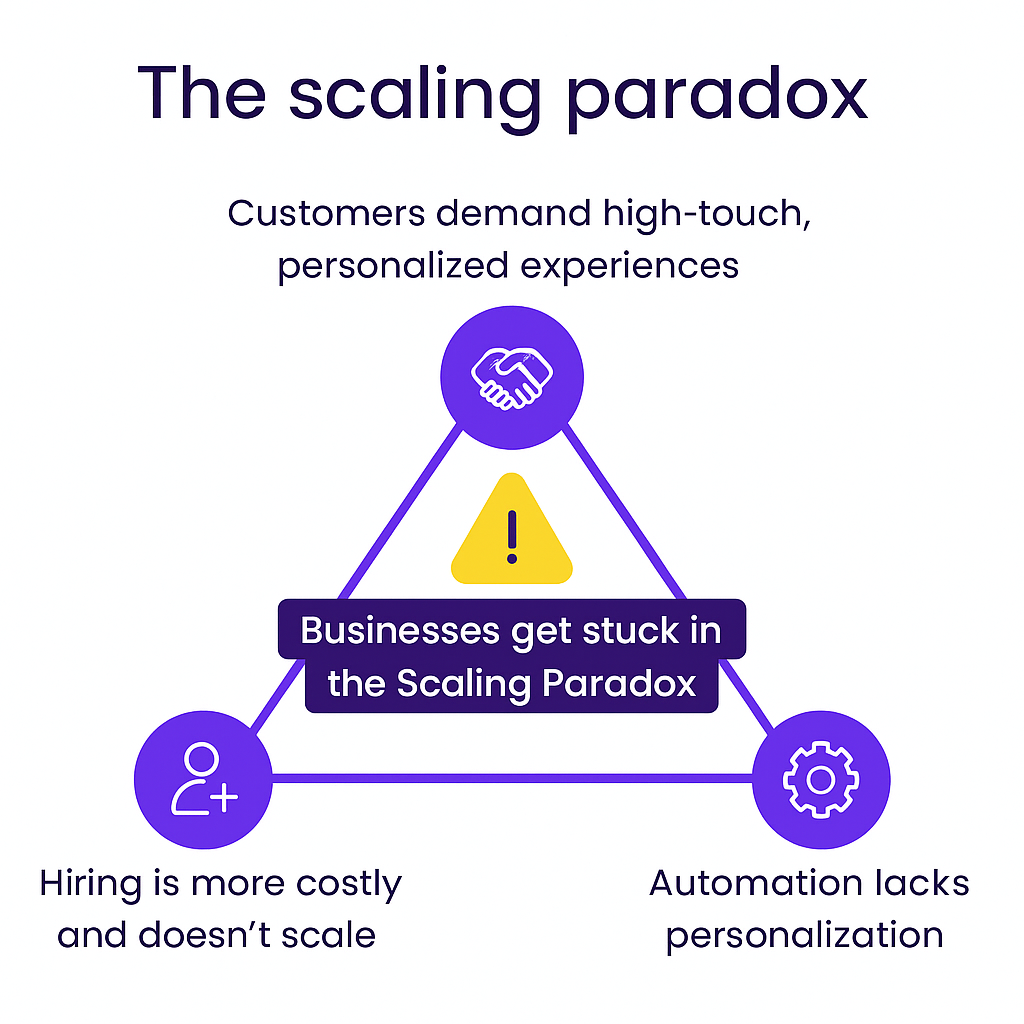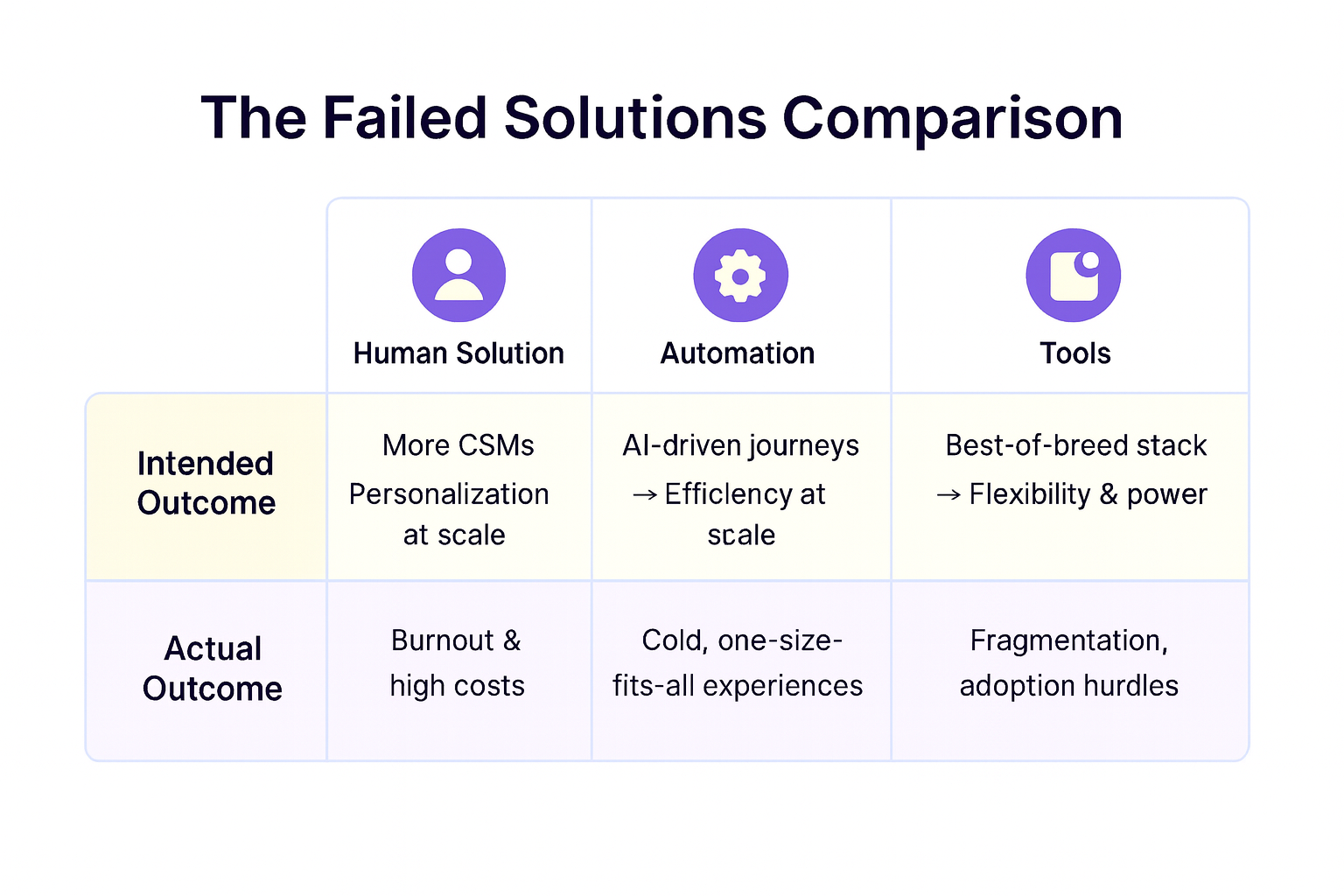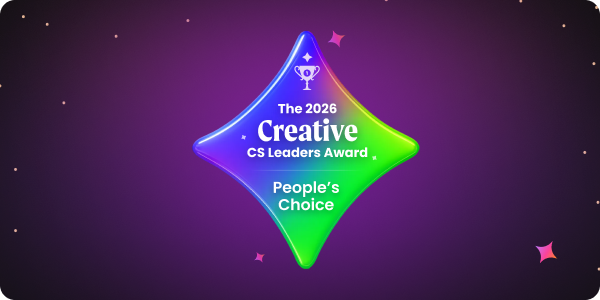TL;DR: The B2B Customer Success Paradox: companies have more customer success tools than ever, yet delivering personalized experiences at scale remains impossible. EverAfter solves this with Customer Interfaces - a new category that combines AI, no-code tools, and real-time data to create scalable, hyper-personalized customer experiences. Just like UI for software and APIs for systems, Customer Interfaces are the missing layer for business relationships.
Why EverAfter?
Imagine explaining to a business executive from 1995 that in 2025, we have software powerful enough to automate nearly every customer interaction. “Amazing!” they’d say. “Customer retention must be effortless now!” But your reply would surprise them: “Actually, it’s harder than ever. We have more tools but less satisfied customers. More data but less meaningful relationships. More automation but customers feel less heard. And despite all this technology, Customer Success teams are burning out, manually trying to deliver personalized experiences to hundreds or even thousands of customers.” Cue their stunned reaction: “Wait… what?”
The Promise That Backfired

As a product person, I've spent my career believing in a simple truth: great technology should make complex problems simpler. When I started building products, the promise was clear. Software would streamline business relationships, making them more efficient and more personal at the same time. Instead, we created what I call the B2B Scaling Paradox.
Here's what I see when I talk to Customer Success leaders today: Every successful B2B company runs 15-20+ customer programs. Onboarding sequences. Success plans. Business reviews. Renewal campaigns. Feature adoption drives. Upsell trigger programs. Partner enablement flows. The list goes on. Each program requires human orchestration. Each customer journey needs personal attention. Each touchpoint demands context and care. The cruel irony? The more successful you become, the more impossible this becomes. You're trapped between two forces: Every company I meet is stuck in this paradox. They know exactly what good customer experience looks like. They just can't deliver it at scale without breaking their economics.
{{benchmarks-report}}
Why Everything We Tried Made It Worse
We've tried three main approaches to solve this, and each one made the problem worse:
The Human Solution: "Just Hire More CSMs"
- The obvious answer seemed to be hiring more Customer Success Managers. More people = more personal attention, right? Wrong.
- The Automation Solution: "Let's Build Workflows". So we swung to the opposite extreme. Marketing automation for customer success. Drip campaigns. Triggered emails. Automated check-ins.The result? Customers immediately recognized generic, automated outreach and tuned it out. We trained an entire generation of B2B buyers to ignore most customer success communications because they felt robotic and irrelevant.
- The Tool Solution: "There's a Platform for That" Then came the platform explosion. CRM systems. Success platforms. Analytics tools. Communication platforms. Project management systems. Survey tools. Each solving one piece of the puzzle.The result? Customer Success teams now spend more time managing their stack than actually succeeding customers. Data lives in silos. Customer context gets lost between platforms. And customers get frustrated by fragmented experiences.
We ended up in the worst of both worlds: expensive to deliver, frustrating to receive.

The Breakthrough Moment
The turning point came during the pandemic. In early 2020, most B2B companies viewed digital customer experiences as a "long tail play". Nice to have for smaller accounts that couldn't justify human attention. That changed overnight. Suddenly, your largest enterprise customers couldn't meet in person. Your biggest accounts needed self-service options. Your most important renewal meetings moved to digital channels. Digital wasn't a long tail play anymore. It was essential for every customer, from smallest trial to largest enterprise. But here's what really changed the game: AI finally became capable of handling the nuance and context that B2B relationships require. For the first time, we could build technology that was both: The missing piece wasn't better CRM or smarter automation. It was an entirely new layer.
Defining the Category: Customer Interface
.png)
Just like we have User Interfaces (UI) for software and Application Programming Interfaces (API) for systems, we need Customer Interfaces for business relationships. A Customer Interface is the digital layer that sits between your company and every customer interaction. Making each touchpoint feel personal, contextual, and valuable while being completely scalable. Think about it this way: When a customer interacts with your product, they're using your User Interface. When systems talk to each other, they use APIs. But when customers need to engage with your company - for onboarding, support, expansion, renewal - what do they use? Today, they get a fragmented mess of emails, Zoom calls, PDFs, and portal logins. There's no coherent interface layer. The Customer Interface changes that.
What 10x Actually Looks Like
.png)
I don't use "10x" lightly. But when you see what happens when companies implement true Customer Interfaces, the results are dramatic.
Okta needed scalable digital success plans for their growing customer base. Before EverAfter, their Digital Success team had no way to deliver success plans at scale. Manual work across disconnected tools made it hard to activate goals and product data for unmanaged accounts. After implementing their Customer Interface, they achieved 3x adoption growth with personalized digital success plans. A senior manager told us: "We have a 3x impact on our weekly adoption globally."
{{cta-demo2}}
Salesloft was trapped in a one-to-many onboarding model that couldn't deliver personalized value at scale, resulting in low engagement and costly inefficiencies for their consulting team. Their Customer Interface enabled personalized, digital customer journeys that scale. Results: 3x increase in digital engagement, 25% faster time-to-value, and 5 hours saved per CSM per week due to less time on admin tasks, more on strategy. A Senior Manager Consultant told us: "With EverAfter, our team spends less time troubleshooting & more time on strategic customer success."
Frontify needed a unified, customer-facing solution to deliver clear, personalized journeys at scale. Their teams relied on manual processes, and siloed efforts between product, marketing, and CS created inconsistent customer experiences. With their Customer Interface, they built a centralized digital hub that supports customers from onboarding through long-term success, achieving an 87% engagement rate. A Director of CS Growth told us: "We needed a platform that could support the entire customer lifecycle, not just onboarding, but everything before and after it as well. EverAfter made that possible."
These aren't just efficiency gains. It's unlocking things that were never possible before.
The AI Multiplier Effect
.png)
Here's where it gets really exciting. AI doesn't just make existing processes faster. It enables entirely new categories of customer experience:
10x Faster: What used to take Customer Success teams weeks to create (custom onboarding plans, business review materials, expansion proposals) now takes hours. Our Interface-Builder Agent can generate complete customer programs from a simple description.
10x Quality: Instead of one-size-fits-all templates, every customer gets hyper-personalized experiences based on their industry, role, company size, product usage, business goals, and current lifecycle stage.
10x Possibilities: Programs that were impossible with human-only delivery are now standard. Imagine running personalized business reviews for 1,000+ customers simultaneously, each with custom insights, recommendations, and next steps based on their specific usage data and business context.
Why Now?
Three forces converged to make this possible:
- Technology Convergence: AI that can handle context and nuance + No-code tools that let non-developers build experiences + Real-time data integration that provides instant insights.
- Market Pressure: Customer expectations are at an all-time high. The consumerization of enterprise means B2B buyers expect the same quality of experience they get from Netflix or Amazon.
- Economic Reality: Teams must do more with less. The era of throwing more headcount at customer success problems is over.
As a product person, I've always believed that the best solutions feel inevitable in retrospect. Customer Interfaces feel inevitable to me now. The question isn't whether this will happen. It's whether you'll lead the change or follow it. Looking at the most creative customer success leaders we work with, they're already there. They're using Customer Interfaces to deliver experiences that seemed impossible just a few years ago.
{{cta-demo2}}
The Future We're Building
We're not just building software. We're defining how B2B companies will relate to their customers for the next decade. Every customer, from your smallest trial user to your largest enterprise account, deserves an experience that feels crafted just for them. They deserve to feel understood, supported, and valued at every stage of their journey. The technology is finally here. AI can now deliver the personalization that B2B relationships require. No-code tools can make this accessible to every team. Real-time data can provide the context that makes every interaction relevant.
But technology alone isn't enough. It takes a product person's mindset to bring together the experience and the system behind it. It takes understanding that great customer experiences aren't just about the touchpoints customers see. They're about the intelligent layer that makes those touchpoints feel effortless and valuable.
That's why we call it a Customer Interface. Like any great interface, it should feel natural, powerful, and invisible to the people using it. The B2B Scaling Paradox isn't unsolvable. We just needed to build the right layer to solve it. Whether you're looking to scale your customer marketing programs, drive more customer expansion, or create more engaging digital customer success experiences, the Customer Interface is how you get there. Ready to see what a true Customer Interface can do for your business? Explore our Success Stack of customer-facing templates and tools, or let's talk.


.png)

.png)

.png)




%20(1).png)
















.png)
.png)
.png)



.avif)





.png)
.png)







